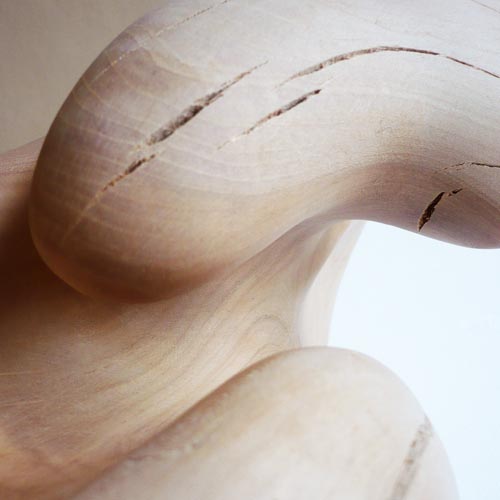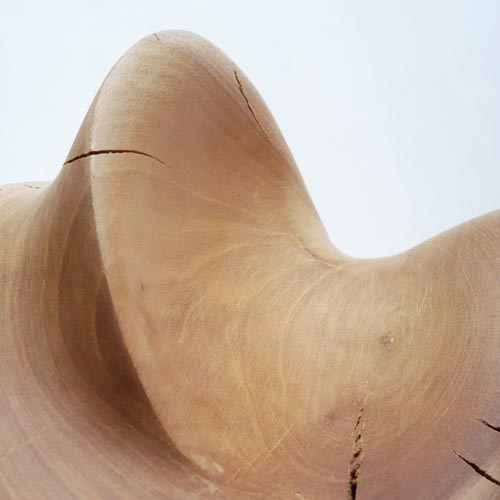One day on my walk to work I saw them cutting down a cherry tree in a garden. Some of the pieces were large enough for me to imagine working with them – they need a certain diameter if you want to do something interesting with it and not just scratch the surface. So I asked, whether I could have those pieces and they promised they would just leave them there for me and I could pick them up in the afternoon. That day I was late for work and I went home early. They left me nine pieces – I had hoped for two or three. As they were freshly cut, they were quite heavy and it took some time to carry all of them into my makeshift workshop in the basement. But I was exhilarated. I had material to work with at home for the first time after the first summer academy. Three of those pieces are finished, one is in progress, and five are still waiting and are by now very dry, meaning: even harder then usual.
 The best title I can find for them is ‘movement studies in cherry’, because that’s what I did: I studied movements. Cherry is a wonderful wood with a softer light red part on the outside surrounding a darker and very hard core. It smells good but sometimes it drove me into despair. It can be really, really hard inside. And working out those movements requires these very smooth surfaces that can only be achieved by going over them again and again with gouge, rasp, different degrees of coarse and then finer and finer sandpaper. It seems a never-ending endeavour. Also: the smoother the surface gets the more accurate the movement has to be. A slight hitch in a curve might be covered up by an overall rough surface. But with up to 280 grade sand paper I had to work out the movements in a precision very near perfection. Only then you really see, and feel, if a line or a curve works or not. It was a good training for lesser tasks in that matter.
The best title I can find for them is ‘movement studies in cherry’, because that’s what I did: I studied movements. Cherry is a wonderful wood with a softer light red part on the outside surrounding a darker and very hard core. It smells good but sometimes it drove me into despair. It can be really, really hard inside. And working out those movements requires these very smooth surfaces that can only be achieved by going over them again and again with gouge, rasp, different degrees of coarse and then finer and finer sandpaper. It seems a never-ending endeavour. Also: the smoother the surface gets the more accurate the movement has to be. A slight hitch in a curve might be covered up by an overall rough surface. But with up to 280 grade sand paper I had to work out the movements in a precision very near perfection. Only then you really see, and feel, if a line or a curve works or not. It was a good training for lesser tasks in that matter.
Another lesson I learned during  these studies is to let go. Sometimes I fall in love with a part of a sculpture. A line, a curve, a specific form or surface. And its joyful to work it out in more and more detail and understand it. But then I look at the entire figure again and realise: As beautiful as this part is, it does not work with the rest. At that point there are two principal directions in which I can proceed. I can change the whole figure (if that is still possible) or I let go of this one part. I usually choose the latter. And I can still keep the memory of the joy. The first time I understood this the understanding was more or less forced on me. I had worked on the end of one of the pieces for several days till near perfection. I loved it. But in the context of the whole figure it made me feel uneasy. Something did not fit although I could not say what it was. And then, out of the blue, a part of that end broke off. I was inconsolable. But not for too long. Once I had dismissed the idea of gluing the broken piece back on, it was more of an eye-opener. I could see a solution that suited the whole figure and was – in the end – even more beautiful then the one I had just lost.
these studies is to let go. Sometimes I fall in love with a part of a sculpture. A line, a curve, a specific form or surface. And its joyful to work it out in more and more detail and understand it. But then I look at the entire figure again and realise: As beautiful as this part is, it does not work with the rest. At that point there are two principal directions in which I can proceed. I can change the whole figure (if that is still possible) or I let go of this one part. I usually choose the latter. And I can still keep the memory of the joy. The first time I understood this the understanding was more or less forced on me. I had worked on the end of one of the pieces for several days till near perfection. I loved it. But in the context of the whole figure it made me feel uneasy. Something did not fit although I could not say what it was. And then, out of the blue, a part of that end broke off. I was inconsolable. But not for too long. Once I had dismissed the idea of gluing the broken piece back on, it was more of an eye-opener. I could see a solution that suited the whole figure and was – in the end – even more beautiful then the one I had just lost.